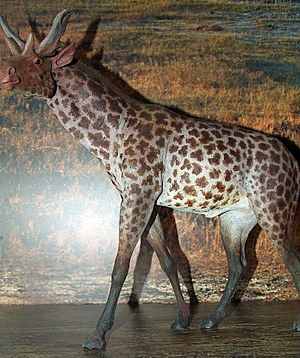Giraffoidea facts for kids
Quick facts for kids Giraffoidea |
|
|---|---|
 |
|
| Reconstruction of Sivatherium | |
| Scientific classification |
|
| Kingdom: | Animalia |
| Phylum: | Chordata |
| Class: | Mammalia |
| Order: | Artiodactyla |
| Infraorder: | Pecora |
| Superfamily: | Giraffoidea |
| Families | |
Giraffoidea is a group of mammals that includes some of the tallest and most unique animals on Earth. Today, the only living members of this group are the amazing giraffes and the shy okapis. But long ago, many other interesting creatures belonged to this superfamily.
Giraffoidea animals are known for their long necks and legs, though some ancient members looked quite different. They are part of a larger group called Pecora, which includes other hoofed animals like deer and cattle.
Contents
What is Giraffoidea?
The term "Giraffoidea" refers to a superfamily of mammals. In biology, a superfamily is a way to group different families of animals that are closely related. Think of it like a big family tree, where Giraffoidea is a major branch.
This group first appeared about 20 million years ago during a time called the Miocene epoch. Many of the animals in this group are now extinct, meaning they no longer live on Earth.
Families in the Giraffoidea Group
The Giraffoidea superfamily includes two main families:
- The Climacoceratidae family (all extinct)
- The Giraffidae family (includes giraffes and okapis)
Let's learn a bit more about these two important families.
The Extinct Climacoceratidae Family
The Climacoceratidae family is a group of ancient animals that are all extinct today. They lived during the Miocene epoch. These animals were somewhat like deer, but they had unique bony growths on their heads called "ossicones."
Unlike deer antlers, which are shed and regrown every year, these ossicones were permanent. They were covered in skin, much like the ossicones of modern giraffes. Some examples of animals from this family include Climacoceras and Prolibytherium.
The Giraffidae Family: Giraffes and Okapis
The Giraffidae family is the other main group within Giraffoidea. This family includes all the giraffes and okapis, both living and extinct. This family also has a long history, with its earliest members appearing millions of years ago.
The Giraffidae family is divided into smaller groups called subfamilies. These subfamilies help scientists organize the different types of giraffes and their relatives.
Ancient Relatives: Sivatheriinae
One important subfamily is called Sivatheriinae. All the animals in this group are now extinct. They were often very large and strong, much bigger than modern giraffes.
A famous member of this group was Sivatherium. This animal looked a bit like a mix between a giraffe and a moose. It had large, branched ossicones on its head and was one of the biggest giraffids ever.
Modern Relatives: Giraffinae
The Giraffinae subfamily includes the ancestors of today's giraffes and okapis. This group is further divided into smaller tribes and subtribes.
The Giraffini Tribe
The Giraffini tribe includes the true giraffes. This group contains the genus Giraffa, which is where all modern giraffes come from. Giraffes are famous for their incredibly long necks and legs, which help them reach leaves high up in trees.
There were also extinct relatives in this tribe, like Bohlinia and Honanotherium. These ancient giraffes help us understand how modern giraffes evolved over time.
The Palaeotragini Tribe
The Palaeotragini tribe is another important group within the Giraffinae subfamily. This tribe includes the ancestors of the okapi.
The only living member of this group is the okapi, or Okapia johnstoni. Okapis are much smaller than giraffes and have shorter necks. They live in the dense forests of central Africa and have unique zebra-like stripes on their legs.
Evolution of Giraffoidea
The story of Giraffoidea began in Africa and Asia during the Miocene epoch. Early members of this group were quite different from the giraffes and okapis we see today. Over millions of years, they evolved and adapted to different environments.
Scientists study fossils of these ancient animals to understand how they changed over time. These fossils show us how features like long necks and unique ossicones developed. The evolution of Giraffoidea is a great example of how animals adapt to their surroundings.
See also
 In Spanish: Giraffoidea para niños
In Spanish: Giraffoidea para niños

